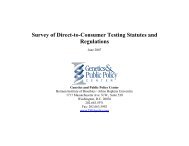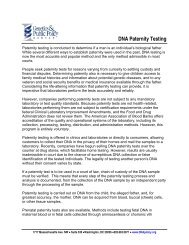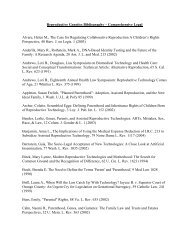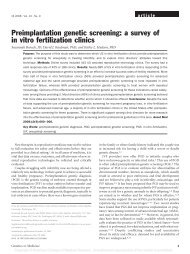Preimplantation Genetic Diagnosis - Genetics & Public Policy Center
Preimplantation Genetic Diagnosis - Genetics & Public Policy Center
Preimplantation Genetic Diagnosis - Genetics & Public Policy Center
Create successful ePaper yourself
Turn your PDF publications into a flip-book with our unique Google optimized e-Paper software.
ADDRESSING USES OF PGD<br />
Non-governmental Approaches<br />
Option: Establish Guidelines Through Patient Groups<br />
Patient groups, which typically are organized around particular<br />
diseases or conditions, could develop their own<br />
recommendations for appropriate use of PGD.<br />
Arguments for:<br />
• Patient groups have special insight about particular<br />
conditions and can offer guidance to prospective parents<br />
who are considering PGD.<br />
• Patient groups may have special insight into the impact of<br />
PGD on people living with genetic diseases and their<br />
families and can provide useful guidance to prospective<br />
parents about the impact of their decision.<br />
Arguments against:<br />
• Guidance from patient groups offers no enforceable limits<br />
on the use of PGD.<br />
• Prospective parents seeking to use PGD for a particular<br />
purpose may have views that conflict with the guidelines of<br />
a patient group.<br />
• Patient groups may be unable to develop guidelines because<br />
of co nflicting opinions within the membership about the<br />
appropriate use of PGD and concern that PGD could affect<br />
the availability of treatments and support for people living<br />
with a particular condition.<br />
• Patient groups may not see PGD guidelines as part of their<br />
mission and may have other priorities for their resources.<br />
• Patient groups would focus on particular diseases and<br />
therefore would be unlikely to address the use of PGD for<br />
trait selection.<br />
Option: Leave Decision to Parents and Providers<br />
Currently it is prospective parents who decide whether to seek<br />
PGD to detect a particular condition or trait. PGD providers,<br />
in turn, make the decisions about what genetic tests they will<br />
offer. Some individual clinics and providers currently refuse to<br />
perform PGD for certain reasons, such as sex selection. This<br />
policy approach would continue to leave decisions about PGD<br />
use to parents and providers.<br />
Arguments for:<br />
• This approach avoids government interference in personal<br />
choices.<br />
• This approach avoids government interference in the<br />
practice of medicine.<br />
• This approach respects the different personal or<br />
professional reasons parents and providers may have for<br />
wanting or refusing to do PGD for various purposes.<br />
• Beliefs about the appropriate use of PGD are rooted in<br />
moral and ethical concerns that are difficult to address<br />
through policy making.<br />
• This approach permits scientific innovation to proceed<br />
unimpeded by government restraints.<br />
Arguments against:<br />
• Leaving the decision to parents and providers does not<br />
provide formal legal limits on the use of PGD.<br />
• Decisions about a technology so profound that it could<br />
shape the future of humanity should not be left entirely to<br />
the discretion of parents and providers. Broader societal<br />
consensus and input is needed.<br />
• Provider policies will be inconsistent, making it difficult for<br />
prospective parents to find services.<br />
• Though difficult to craft, it is not unusual or inappropriate<br />
for policy to respond to moral or ethical concerns.<br />
• PGD has consequences for the resulting children that are<br />
not adequately considered or protected with this approach.<br />
16<br />
VISIT WWW.DNAPOLICY.ORG TO COMMENT










